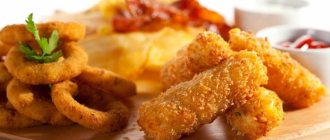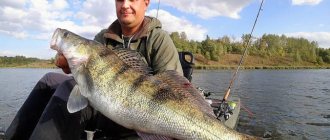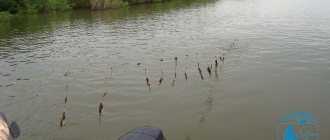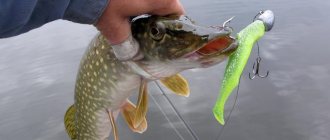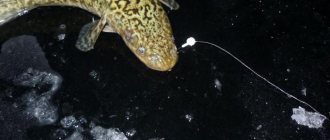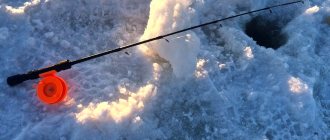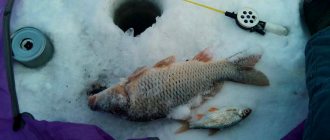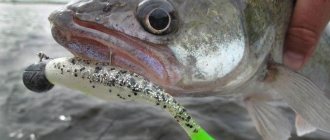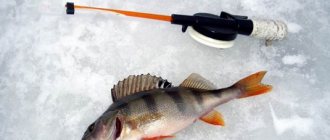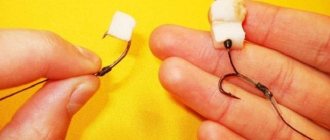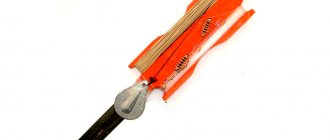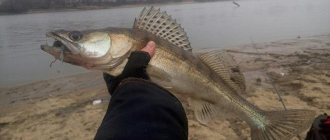This method of catching pike perch is used everywhere in ponds and rivers. Moreover, all fishermen hunt for such a difficult predator throughout the year. In summer and autumn, many types of gear and fishing methods are used.
Walleye is a predator that can be caught all day long. It is worth noting that getting live bait will not be difficult, the main thing is to prepare in advance.
Fishing with live bait is promising, because using this method you can get a trophy. In this case, it all depends on the right location and the assembled gear.
Catching pike perch with live bait
A novice fisherman, before starting to prepare for catching pike perch using live bait, needs to become familiar with the advantages and disadvantages of this method. After all, for some personal reasons, this type of fishing may not be suitable.
Advantages:
- This method is more effective than using a spinning rod. It is good when the pike perch behaves cautiously, since natural prey causes less doubt in it - the predator will be more willing to attack it.
- You can fish with live bait using several gears at once, which significantly increases the chances of getting a trophy.
- Fishing with live bait is a passive activity, which allows the angler to relax in nature or read his favorite book.
Flaws:
- The trouble with choosing this method is fiddling with live bait. Experienced fishermen have repeatedly noticed that when the need arises to catch fry, they immediately disappear from everywhere. This is why you should take care of this problem in advance.
- To keep the fry alive, you need a large container of water and a cool place (a basement or cellar is perfect).
- In a large water area, to successfully catch pike perch, you need a boat. It is especially necessary in the autumn, when the predator prefers to accumulate in the riverbed edges away from the coastline.
What is better to use - fry or sprat?
A notable feature of this predator is that it feeds only on live fish, so there is a need to use only the most active and viable bait as bait, which will definitely attract attention.
In those reservoirs where a large number of fry live, it is better to use it, as it is a tasty prey for pike perch. An alternative to such bait is sprat. It is used during bottom fishing, and, as is known, this fish hunts only in the lower part of the water body.
Advice! You should always choose the largest individual for the role of live bait (up to 7 cm long), as it can attract a hefty predator.
Also, when storing live bait, you should pay attention to:
- What type of fish does it belong to (if it is a bottom fish, then it will live longer, but if it is a surface fish, then there is a high probability of death in conditions outside the reservoir).
- It is worth periodically changing the water in which the bait is located. In addition, it is necessary to clearly monitor the oxygen level in the water (if the fish is at the surface and takes in air with its mouth, it’s time to change the water).
- Make sure that the water has a temperature of 15–20 degrees.
- Do not place a predator with regular fish in the same vessel.
- The container containing the live bait must be placed in a dark place (if it is very hot outside, it must be additionally covered with a wet cloth).
How to properly place live bait on a hook
Hooking methods:
- For the tail section. This is the easiest method, which implies that the hook will be inserted into the body at the tail.
- Behind your back. This method is most suitable for bottom fishing, as it avoids the fishing line getting caught on snags and other debris. When attaching, you should remember that the hook must be hooked to the skin and you must avoid damaging the spine, as the bait will quickly die because of this.
- Per head. This method is best suited for bodies of water with fast currents. The hook is directly attached to the lips or nostrils (the sting of the hook comes out either through the cheek or through the gill cover).
In addition, there is another quite popular method that does not damage the bait at all. It consists of purchasing a special thread with which the fry will be tied.
Advice! When baited, large hooks severely injure live bait. Therefore, experienced fishermen use medium and small sized gear.
When the bait is attached to one hook, the fry will receive much more damage than if it were attached to two stings at the same time. Then the live bait will be less active, but it will remain viable for a much longer period of time.
Fishing on a balance beam
With the onset of cold weather, the fish continue to lead an active lifestyle to the fullest for some time, so until about mid-December it is important to catch pike perch using a balance beam. In winter, this method can be used both during the thaw and before the onset of spring.
Tackle
The main feature of this kind of fishing in winter is the use of a balancer - a special spoon that looks like a real small fish. A triple or double hook is suspended from the belly of the bait, and a loop in the upper fin helps to tie the spoon so that during fishing the fish behaves exactly like real pike perch prey.
Among the many models presented, the following balancers work best on pike perch:
- silver-colored iron;
- metal-based silicone;
- with a transparent plastic tail.
The optimal size is 50-70 millimeters.
The fishing rod should not be very long - up to 50 centimeters. Choose a product with maximum rigidity so that active fishing for pike perch on a balance beam in winter will be easier for you.
In addition, the chosen fishing line is important - as a rule, the thinner it is, the better it resists active river movement, but at the same time it stretches greatly. Therefore, select fishing lines of medium parameters with a thickness of approximately 0.3 millimeters.
Peculiarities
It’s not for nothing that winter fishing for pike perch on a balance beam is called active - to create the illusion of a living, moving bait, the fisherman needs to work hard. In this case, it is better to give the fish swimming movements not with the help of a reel, but by rotating the fishing rod in your hands - this way the game turns out to be more natural.
Despite the fact that many methods of fishing are used, there is a classic option - giving the trajectory of the bait a figure eight shape. The actions are shown schematically in the figure:
If you feel a school of pike perch approaching, hook them with sharp, sweeping movements. To make fishing easier, an echo sounder and even an underwater video camera can be used. Ideally, you need to try about 15 holes at a time before you manage to find the fish trail and get your well-deserved trophy.
Fishing for pike perch in winter using a spoon called a jig works in a similar way. It looks the same as the balancer, but the weight is not located in the tail part, but is attached to the head of the bait and is an independent element.
You can learn more about catching pike perch in winter using a balance beam in the following video:
Features of using bait depending on the season
The predator has an established diet of prey, to which it is accustomed and trusts. Let's look at how it changes in pike perch in different seasons of the year.
Optimal bait for catching pike perch in the fall
In the autumn, fishing for pike perch will bring great pleasure and, if you're lucky, will give you the opportunity to catch a trophy.
The best choice of bait during this period is white bream or silver bream.
What baits are best to use in summer?
During this season, the predator, as a rule, has already had enough and conducts its hunt throughout the entire reservoir. Therefore, consider the following nuances:
- the performance is directly affected by the current: the greater it is, the more active the pike perch behaves;
- if the bottom of the reservoir is rocky or sandy, then this is definitely the habitat of this predator.
The best bait for bait is small fish from the same reservoir. The best options are minnows and medium-sized roach.
Spawning
Considering that the fish easily adapts to local conditions, it is currently quite difficult to separate the different ecological forms of this fish. The fish becomes sexually mature at 1-2 years. Tulka is a schooling fish, the composition of groups is mixed, with a predominance of 2-3 young ones. Depending on the preference for places of residence, it reproduces in different conditions: from seas to rivers, lakes and reservoirs, usually far from the coast. Spawns in the spring, over a fairly wide period of time, depending on the natural conditions and characteristics of the region. The spawn is portioned at intervals of several days. Migratory forms can enter rivers to spawn in the fall.
Some tips for using bait from live or dead fish
Towards the end of autumn, pike perch begins to eat, which will last until the end of November and the onset of the first ice. During this period, it will be better caught on a donk, so you need to choose live bait from its characteristic habitat.
In winter, it is best to carefully study the topography of the bottom of the reservoir before fishing. It will lie in deep places where the water is warmer. If you manage to catch one individual, then you can say with great confidence that there are more representatives of this species nearby, since it hunts in a flock.
The predator's spring feeding period ends around the beginning of June. Spawning occurs in April or May. Everything will depend on weather conditions and how quickly the water heats up.
The bait used is whitebait, which is found in large numbers in this reservoir.
Since the predator often swallows the bait deeply, you should prepare a tool for removing the hook in advance, otherwise problems will arise.
Pike-perch likes to hunt in a school, but large representatives of this species like to stay apart.
Fish habitats
Catching pike perch in winter requires mandatory preparation, which begins even before the onset of cold weather. Fishermen pre-select places where the probability of catching fish is maximum. These include wide fast rivers, the mouths of large rivers, and basins of seas such as the Azov, Black, Caspian, and Aral seas.
Pike perch is a predatory fish that loves to hunt in the dark. Therefore, the best fishing begins at sunset and lasts until dawn.
With the onset of cold weather, the animal sinks to the bottom, where the temperature is highest - up to 4 degrees Celsius. Therefore, in winter, pike perch can be found, as a rule, in holes, depressions, places with a sharp change in depth, under snags - in this sense, fishing is reminiscent of fishing for catfish. In this case, the fish prefers a hard bottom - sandy or pebble.
However, during the hunt, hungry fish often appear in the shallows, near sea spits, embankments, and piles. In shallow water it is also easy to find schools of young pike perch. Therefore, only a long persistent search will help you determine the “fishing” place.
Professional fishermen have noticed that the best fishing for pike perch in winter takes place in February, when the weather is calm, frosty, and clear. However, hungry fish go looking for food even during cloudy and rainy periods.
Fishing with lures and sprat
In winter tackle for trolling pike perch, a very important element is the rod. Particular attention should be paid to the whip , which must be made of durable and rigid material that can withstand negative temperatures well. The increased rigidity of the whip will ensure good sensitivity of the tackle and will allow you to easily cut through the hard mouth of a predator.
Choosing a fishing strategy
There are two main strategies for fishing for pike perch in winter. If the angler is familiar with the routes of fish movement and the reservoir, he can drill several holes in the most promising places, arrange the gear and wait for the fish to approach. This method is usually used by fishermen who live on the shore of a reservoir and are well aware of the habits of the local predator. For such fishing, jigging gear or rigs are better suited.
The second method is more suitable for anglers who prefer to actively search for fish and are not very familiar with the behavior of a predator in a particular body of water. Having drilled a hole, the fisherman fishes on it for 3-5 minutes. If there is no bite, you need to move to another place. As a rule, a fisherman has to drill dozens of holes before he finds a school of pike perch. For the search method, it is better to use a fishing rod equipped with a spoon.
Both methods can be very effective. When a predator actively moves through a body of water in search of prey, the first method may be the most effective. If the pike perch is passive and stands in holes and snags, only a constant search will bring the expected result.
Where to look for pike perch sites
This predator is caught throughout the year in open areas of water bodies. But the most catchy period and trophy fishing is considered to be autumn. Starting from mid-September until the first frosts (second half or end of November), the fanged one fattens up before wintering. Therefore, it feeds very actively, often losing vigilance, which plays into the hands of fishermen.
Favorite stops include:
- trees fallen into the water, under snags
- channel ditches
- areas with changes in flow direction
- sharp deep drops
- eyebrows
- changes in the bottom in the form of mounds or holes
- pools near hydraulic structures, bridges
- near bottom boulders
As the outside temperature drops, it goes deeper, so you need to look near wintering pits that are up to 15 m deep. The autumn predator bites not only at night, but throughout the day, especially when the weather is cloudy. Although experienced fishermen believe that at night there is a much greater chance of catching a trophy pike perch.
Selecting a location
In many ways, the result of fishing depends on proper preparation, namely gear. The fishing rod should have a whip (it doesn’t need to be too long, a medium one will suffice), a 70-90 mm reel, preferably a strong reel, because This is a fairly active fish.
The fishing line must be appropriate - the optimal thickness is 0.35 mm. It is worth remembering that the fishing line for winter fishing must be coated with polymer resin.
The leash should be small - even 5 cm is enough. If you make it too short or, on the contrary, long, the fish will not swallow the bait, but will bite the line.
We also approach the choice of jigs responsibly - they should be marked, ideally with luminous paint - the fact is that pike perch, due to their nocturnal lifestyle, reacts perfectly to light in the dark.
You can also catch pike perch using a similar rig using girders. Use the guide for pike rigs, the only differences are in the installation that you see on this page.
The best improvement to the equipment would be to use a brighter knocker; there are a great many of them in stores. In general, by using exactly the installation that we recommend, you will already have gear with an enviable advantage over other anglers. Because often the use of a swivel, 3 hooks and a knocker goes by the wayside. But in vain.
How to catch pike perch?
- Fish a large area at once.
- Fish in potentially attractive areas for pike perch, gradually moving from one place to another. Each method is better in some ways and worse in others.
For example, if you actively look for pike perch, the likelihood of catching it is significantly higher. And vice versa - the pike perch can get scared and hide. The fish sometimes bites and is caught only after several hours of fishing after a number of unsuccessful attempts and many holes.
Finding a school of walleyes can be quite challenging during the winter months. Simply feeding the hole in places where there was an active summer bite will not bring the desired result.
For those fishermen who do not want to wait for pike perch on the shore, there is an excellent way to “visit” them in the hole where they usually feed. To organize such fishing, you cannot do without a watercraft, and the method of fishing is called: catching pike perch from a boat in a plumb line.
Place and time
The time when you can catch fish in this way begins early in the morning and can last all day until the evening dawn.
The advantage of this method of fishing is that even a passive pike perch, which is located in a deep hole for an “afternoon rest,” can be easily caught with a vertical lure if positioned for fishing directly above the hole.
When choosing gear for winter fishing for pike perch, you need to take into account the rather large size and strength of this fish. In this regard, all components must be durable and of high quality.
To catch pike perch using sprat in winter, you can try to catch the bait yourself. Such small fish should be caught with the help of a little fish, or “spider”. The device is a frame made of square wire, covered with a fine nylon mesh or gauze. From the corners there are uprights that connect at the top and are tied to a thick fishing line or rope.
But in winter, catching sprat is quite difficult and inconvenient - open water is required. Therefore, it’s enough just to buy fresh frozen fish in the store. You should not choose a large sprat - it should be no more than 5 centimeters in length. Of course, trophy fish will also bite on larger bait. But the average pike perch weighing 2-3 kg will simply bite off half the fish without catching the hook.
There is no need to be afraid of sprat with “rust” - pike perch willingly takes such bait. The main thing is that the fish cannot be defrosted and frozen several times. In this case, it becomes too soft and easily slides off the hook.
It is not easy to find pike perch under the ice - schools move throughout the entire reservoir and you have to walk several kilometers in search of a suitable place.
In this regard, it is better to try to catch pike perch during short stops in the following places:
- pits;
- stuck areas;
- eyebrows;
- depth changes;
- areas with variable currents;
- high and shallow waters at the beginning and end of winter;
- rubble of stones.
The main guarantee of a good catch is knowledge of the reservoir where you plan to catch pike perch.
When fishing with girders, a single hook with a sliding weight and without a steel leash is used; the live bait rises 10 - 20 centimeters from the bottom.
You can also bait a dead frozen sprat onto the hook of a zherlitsa; such tackle is called a postavusha. From time to time you need to approach her and jump up.
Fishing rod for winter trolling
We are preparing the tackle. Take a rigid fishing rod 50–70 centimeters long in order to pierce the jaw of a pike perch that has bitten at a depth of 10 meters. It is advisable to equip the bit with an aluminum reel; it lasts longer and is more reliable. The nod is at your discretion, but in accordance with the sinker used.
It is the sinker, and not the jig or jig - the head. If you fish without a nod, the rod ends in a ring - a tulip. The fishing line most often used is monofilament with a diameter of 0.30 - 0.35 or winter braid with a polymer coating of 0.18. But it should be taken into account that in severe frost it may freeze up and be ineffective. Mormyshka or jig - head.
Fishing with a jig
And now about the hooks and methods of installation for this gear. A few years ago, when fishing for pike perch with sprat was just coming into use, everything was simple and clear. Jig - a head from 15 to 20 grams, above the main fishing line a jig was tied - a boat with one large hook and a sprat was attached behind the eye. Subsequently, fishermen tried to improve the equipment.
Many people use this scheme: fishing line 0.25 - 0.35; lead jig, coated with phosphorus or painted in a bright lemon color; an additional leash 15 -20 centimeters long at a height of 20 - 30 centimeters from the main jig, equipped with a plastic jig with phosphorus filler and a necessarily long shank of the hook to attach the sprat along the entire length of the back.
Pike perch is caught mainly with the upper jig, and rarely takes the lower one. The lower jig head or jig can be replaced with a weight with a swivel or a “Cheburashka”.
When fishing for fish from a hole, the lower jig is hooked onto the ice; it is recommended to make the leash 5 centimeters long from a fishing line of the same diameter or a little thinner. A short leash maintains the sensitivity of the tackle, regardless of which side the pike perch attacks from.
Will need
- bait
- fishing rod with line
- jig or jig - head
- spoon
- nod
The size of the fish should not exceed 5 centimeters. The pike perch has a narrow throat; it cannot swallow large fish whole. If the fish is large, it is cut into pieces. Do not defrost again, which leads to loosening of the bait on the hook, since the fish is oily.
In the intended fishing location, determine by the presence of bites the place where the pike perch is hiding. Use several holes and fishing rods at once, periodically losing with each one - this type of fishing will be much more effective.
